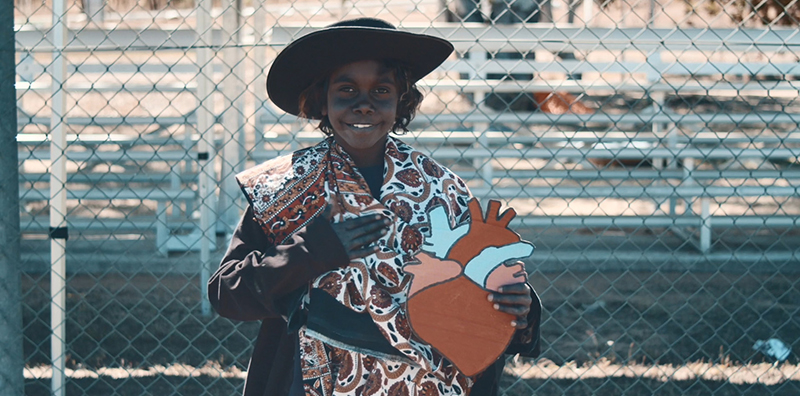
Once you hear it, you won’t be able to get it out of your head – and that’s exactly the point of the new song ‘Boom Boom’. Written for kids, by kids from the remote Aboriginal community of Barunga, the song aims to teach children how to prevent deadly rheumatic heart disease (RHD).
Wanting to share their learnings about RHD to help their peers in other communities with high rates of the disease, the idea of ‘Boom Boom’ was born, and ABC presenter Justine Clarke and Darwin record label Skinnyfish Music were enlisted to help bring the vision to life.
The song was launched at the opening ceremony of the Barunga Festival – a three-day cultural extravaganza that attracts people from across the country – and has now been turned into a music video to be shared throughout communities at high risk of RHD.
Aboriginal Community Worker Anne Marie Lee, who is leading the ‘END RHD Communities’ project in Barunga, has high hopes that ‘Boom Boom’ will help other communities consider key messages to prevent RHD.
“By doing this video in an Indigenous community it opens the eyes of a lot of families members that have rheumatic heart disease – and families with kids that don't – about how it’s important that they get treatment for skin sores and sore throats,” she says.
“Seeing the video opened my heart and brought a tear to my eye. It’s going to be very useful for a lot of Indigenous communities.”
In 2018 the ‘END RHD Communities’ project – a community-led, research-backed approach to ending RHD – began in Barunga, supported by the Bupa Health Foundation and driven by the End Rheumatic Heart Disease Centre of Research Excellence (END RHD CRE) based at The Kids, and the Menzies School of Health Research.
The project aims to bring together the community, service-providers, local school and researchers to develop culturally appropriate approaches to prevent RHD and ensure those already living with the disease receive the support they need.
Most at risk of developing the disease are children aged 5-15, so a big part of Anne Marie’s role has been working with families, the local school and health services in the community to teach kids about what they can do to prevent Strep A infection that leads to RHD.
“The families involved in the project are really happy. We work very closely with them to try and stop rheumatic heart disease and get them to help spread the word,” Anne Marie says.
RHD is a life-threatening, permanent form of heart damage that can occur when a Strep A infection of the throat (Strep throat) or skin goes untreated. There is no cure for the condition, but those living with RHD are required to have a monthly injection of penicillin for at least a decade to stop the disease getting worse.
In Australia, 89% of people living with RHD or its precursor, acute rheumatic fever (ARF), are Aboriginal and/or Torres Strait Islanders, and the Barkly region – which includes the community of Barunga – has the second highest rate of ARF in the country.
The music video was made possible with thanks to funding by the Bupa Health Foundation.
